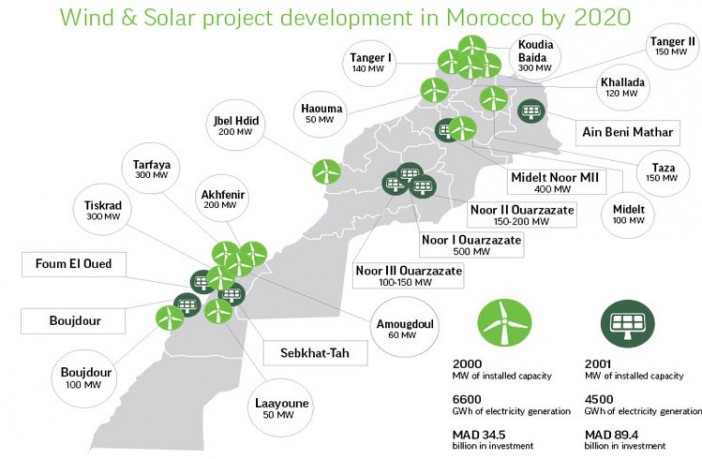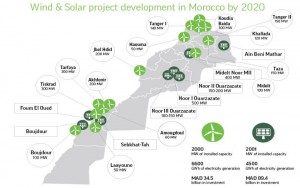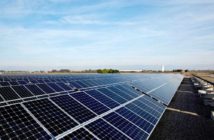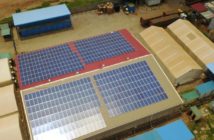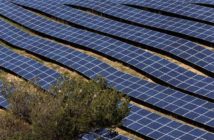SeeNews
The rising star of Morocco’s renewable energy market.
When it comes to clean energy projects in developing countries, Morocco stands out big time with a bold target of sourcing more than half of its electrical energy from renewable sources by 2030 and a firm plan to have 2,000 MW of wind and 2,000 MW of solar power plants by 2020.
The North African kingdom, which hosted in Marrakesh COP 22, the 2016 UN climate change conference, already has а pretty detailed plan as to how it will transform the country’s energy mix.
SOLAR POWER
Noor Ouarzazate
In February 2016, Morocco was all over the news with the official launch of the 160-MW first phase of its giant 580 MW Noor solar project near the trading city of Ouarzazate.
The Noor I plant has covered 480 hectares of land with 500,000 thermosolar cylindrical parabolic troughs. These twelve-metre-high, crescent-shaped solar mirrors are coupled with three hours of energy storage capability and their annual output of about 500 GWh of solar power is estimated to supply the needs of over 500,000 local households.
Moroccan media valued the overall investment for this first phase at between MAD 6.3 billion (USD 652m/EUR 577m) and MAD 8 billion (USD 826m/EUR 734m), while the contracted power purchase price is MAD 1.6 (USD 0.159/EUR 0.150) per kWh.
The EUR-810-million second phase Noor II will also use thermosolar cylindrical parabolic troughs which will spread over an area of 680 hectares. The plant will have a nameplate capacity of 200 MW, coupled with seven hours of energy storage capability. It will sell its electricity output at MAD 1.36 per kWh.
The third phase — Noor III, will spread on an area of 750 hectares. It will have an installed capacity of 150 MW but it will employ a different CSP technology — a central tower with salt receivers, plus seven to eight hours of energy storage capability. This installation will sell power at MAD 1.42 per kWh while construction costs have been estimated at EUR 645 million.
The last phase of the complex — Noor IV, will be developed on a surface of 210 hectares with photovoltaic (PV) technology. It will have a capacity of 70 MW.
A consortium led by Saudi Arabia power and water project developer ACWA Power has been selected to develop all four phases of the project.
The launch of construction works for the second and third phase of the mega project took place immediately after the inauguration of the first. Both phases are expected to start producing electricity in 2018.
The contract for the 70-MW fourth phase was awarded to ACWA Power in November 2016, along with the contracts for 100 MW of two other PV projects. ACWA Power submitted the lowest tariff price for the project at MAD 0.46/kWh or USD 0.048/kWh. The company then said it plans to start construction in the first quarter of 2017 and complete the work within 12 months.
When fully completed, the Noor Ouarzazate complex will be the world’s largest multi-technology solar power plant with 580 MW of nameplate capacity and an overall investment of more than MAD 24 billion.
But it is the project’s funding model has been singled out as one of Morocco’s key achievements.
The Moroccan Agency for Sustainable Energy (Masen) was able to use funds borrowed by the government from multilateral agencies and banks and then lend the money on to the project company. Masen had the lead role of organising the invitations to tender for the plants at each of the five sites. It also acted as a consolidator of concessional loans provided by the Clean Technology Fund, African Development Bank, the World Bank, and the European Investment Bank (EIB), thus reducing the cost of capital for developers, and lowering the overall cost of energy generated. The Noor Ouarzazate funding and development model could work as a template for future renewable projects.
The Noor solar power programme of the kingdom kicked off in 2010 with projects to be sited near five major cities: Ouarzazate, Laayoune, Boujdour, Midelt and Tata.
After a restructuring last year, Masen has officially taken the lead for the development of all renewable energy technologies. Over a transitional period of five years Moroccan electricity and water utility company ONEE will gradually transfer to Masen all properties, including real estate, as well as contracts and employees related to renewable energy generation.
Meanwhile, ONEE is implementing its own solar power programme for 500 MW by 2020, including three large projects – the 120 MW Noor-Tafilalet, the 200 MW Noor-Atlas and the 100 MW Noor Argana.
ONEE-lead projects
Noor Tafilalt
The Noor Tafilalt (or Noor Tafilalet as the tender is also known) was announced in July 2015, initially with a capacity of 75 MWp. ONEE later decided to raise the overall capacity to 120 MWp, comprising three PV power plant projects, each with a nameplate capacity of 40 MWp, to be build in Arfoud, Missour and Zagora in the southeastern part of the country.
In November 2016, the utility named 11 pre-qualified bidders – five companies and six consortia, including Greek Aktor SA; Chinese-South Korea partnership Chint/ KT Corporation; another Chinese consortium CNTIC/Yingly; a consortium of Portuguese Efacec and Moroccan Energy Transfo; a consortium including US First Solar, Italian Belectric and Moroccan Cegelec; a consortium of Spanish Inabensa, its Moroccan unit Inabensa Maroc and Endesa Ingeneria; Chinese Sepco III; a consortium of Swiss based Sunpower Systems Sarl and Moroccan Temasol; Italian Ternienergia Spa; and a consortium of Spanish TSK and French Gensun.
The projects will be built under turnkey contracts with an additional contract for operation and maintenance over five years. Commissioning is scheduled for 2018.
Financing will be provided by the World Bank. The latter has previously said it will extend a USD-125-million loan to ONEE, through the International Bank for Reconstruction and Development (IBRD) and another USD-23.95-million loan through the Clean Technology Fund.
Pre-qualification tenders for two other PV power plants of 200 MW each — Noor Atlas and Noor Argana, should be launched over the course of the current year.
Noor Atlas
According to the initially announced design, Noor-Atlas will comprise eight photovoltaic (PV) plants of 10 MW to 30 MW each. Three of the PV plants will be sited near Tata, Tahla (Bouizakarne) and Tan Tan, in the southern part of the country, and five solar farms will be located to the east at Outat El Haj, Ain Beni Mathar, Boudnib, Bouanane and Boulmane (Enjil).
The overall investment for Noor-Atlas is estimated at EUR 300 million, which will be partially financed through German KfW and the EIB, as well as by a contribution from the European Commission.
Noor Argana
Noor Argana’s capacity will range from 200 MW to 225 MW, including areas around Tensift, Errhamna, Chichaoua and Boumalne in western Morocco, according to information by Moroccan daily Le Matin, published in July 2016.
The daily then said ONEE was negotiating with three European financing institutions to help foot the bill for the project whose price tag now stands at EUR 350 million. These are German government-owned development bank KfW, the EIB and France’s Agence francaise de developpement (AFD).
MASEN-lead projects
Noor Laayoune and Noor Boujdour
In November 2016, MASEN awarded a 20-year build-own-operate-transfer (BOOT) agreement to ACWA Power for an 80-MW PV project Laayoune, and another 20-MW PV project in Boujdour.
The projects in Boujdour and Laayoune will use polycrystalline solar panels mounted on a single-axis tracking system. Financing for both of them will come from a green bond issue that Masen announced in the autumn.
At the COP22 meeting in November, Masen also said it would open the bidding for two 400 MW combined PV and CSP plants in early 2017.
The agency has already launched a call for expression of interest for the development of 400 MW at the Noor Midelt solar power complex in July 2016. The shortlisted candidates should be announced in the first half of 2017.
By design, about 3,000 hectares, some 25 kilometres to the northeast of Midelt, have been zoned for the installation of PV or CSP plants. The installed CSP capacity will range between 150 and 190 MW per power plant with a minimum of 5 hours storage capacity, according to the pre-qualification documents.
Since Morocco has raised its renewable energy target from 42% by 2020 to 52% by 2030, Masen has started talks to arrange financing for the development of 800 MW solar power in the Noor Midelt and 800 MW more at another complex called Noor Tata.
WIND POWER
In terms of wind power development, Morocco enjoys quite favourable wind resource patterns, both in the northern part of the country near Tanger and to the west where certain regions benefit from regular trade winds.
For example, the 300-MW Tarfaya wind farm, developed by Tarec (Trarfaya Energy Company), a 50/50 joint venture of Nareva Holding and International Power Ltd of Engie Group, enjoys a load factor of 45%, one of the best in the world for onshore wind.
In 2010, the kingdom launched the development of 1,000 MW of wind power in two phases. The first phase — a 150 MW wind farm in Taza was awarded to a consortium of French EDF Energies Nouvelle and Japanese Mitsui in 2012. It is slated for completion this year.
Last year, Morocco awarded the second, 850-MW phase via a tender to Italy’s Enel Green Power SpA (BIT:EGPW), in consortium with Moroccan Nareva Holding and Siemens Wind Power AS. The consortium will build five projects — the 150 MW Tanger 2 in the northern part of the country, 300 MW at Tiskrad, Laayoune, 200 MW at Jbel Lahdid, Essaouira, 100 MW near Boujdour, and 100 MW at Midelt, some 400 km east of Casablanca.
The tender hаs attracted bids of about MAD 300 (USD 30/EUR 28) per MWh on average.
All wind farms will be developed under public private partnership and structured under the build, own, operate and transfer (BOOT) scheme. Commissioning of the tender projects is expected between 2017 and 2020.
Potential
Wind power could be a major contributor in the electricity sector of Morocco. According to data presented by minister Amara in Madrid in 2015, the country’s onshore potential is estimated at 25 GW, of which 6 GW could be installed by 2030. The average wind speed is 5.3 metres per second (m/s) at more than 90% of the country’s territory, according to the wind atlas, developed by the Moroccan Renewable Energy Development Center (CDER). The Tanger and Tetouan region (North of Morocco) measured particularly high at 8 to 11 m/s, and 7 to 8.5 m/s were recorded for Dakhla, Tarfaya, Taza and Essaouira.
The wind sector has also attracted most of the private initiative for renewable energy development in Morocco under the 13/09 law that allows private producers to sell electricity directly to clients connected to the high voltage and medium voltage grid, mainly industrial companies.
According to data from Morocco’s energy ministry, a total of 220 MW of private wind energy projects have been built until the end of 2016.
Another 120 MW are to go online soon at the Khalladi wind farm in the vicinity of Tangiers, northern Morocco. The European Bank for Reconstruction and Development (EBRD) and Banque Marocaine du Commerce Exterieur (BMCE) have announced they will provide a financing package of EUR 126 million (USD 133.3m) for the development of the project.
Khalladi will be the EBRD’s and BMCE’s first renewable project relying on commercial offtake agreements and not on any state support.
In July 2016, developer ACWA Power Khalladi has confirmed final orders to suppliers and contractors. and Denmark’s Vestas Wind Systems A/S (CPH:VWS) confirmed in August it signed a firm and unconditional order to supply 40 units of its V90-3.0 MW wind turbines for the project.
At the close of 2016, Moroccan energy group Nareva, a subsidiary of the royal holding company Société Nationale d’Investissement (SNI), announced it is starting work on a EUR-400-million wind farm, its fifth as an independent power producer (IPP).
The 201.6 MW project named Aftissat is located south of Boujdour, a town near Western Sahara where trade winds are strong. It is being developed by Energie Eolien du Maroc (EEM), a company in which Nareva holds 75% and the remaining 25% are owned by Moroccan pension fund Caisse Interprofessionnelle Marocaine de Retraites (CIMR).
The cost of development has been estimated at MAD 4 billion, approximately EUR 370 million, which will be financed with own funds and with a loan provided by Moroccan banks Attijariwafa bank and Banque Centrale Populaire (BCP).
A 400-kV high-voltage power line will be built to connect the future wind farm to the national grid at Laayoune.
Commissioning is planned for December 2018.
Author
Mariyana Yaneva
Published Jan 21, 2017 18:56 CEST
Share this story




